Science in the medieval Islamic world
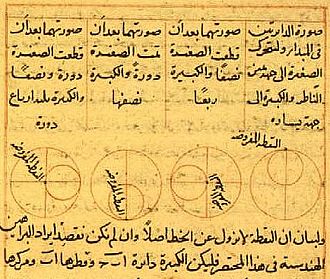
Science in the medieval Islamic world was the science developed and practised during the Islamic Golden Age under the Umayyads of Córdoba, the Abbadids of Seville, the Samanids, the Ziyarids, the Buyids in Persia, the Abbasid Caliphate and beyond, spanning the period c. 800 to 1250. Islamic scientific achievements encompassed a wide range of subject areas, especially astronomy, mathematics, and medicine. Other subjects of scientific inquiry included alchemy and chemistry, botany, geography and cartography, ophthalmology, pharmacology, physics, and zoology.
Medieval Islamic science had practical purposes as well as the goal of understanding. For example, astronomy was useful for determining the Qibla, the direction in which to pray, botany had practical application in agriculture, as in the works of Ibn Bassal and Ibn al-'Awwam, and geography enabled Abu Zayd al-Balkhi to make accurate maps. Islamic mathematicians such as al-Khwarizmi, Avicenna and Jamshīd al-Kāshī developed methods in algebra, geometry and trigonometry. Islamic doctors described diseases like smallpox and measles and challenged classical Greek medical theory. Al-Biruni, Avicenna and others described the preparation of hundreds of drugs made from medicinal plants and chemical compounds. Islamic physicists studied optics and mechanics (as well as astronomy) and criticised Aristotle's view of motion.
The significance of medieval Islamic science has been debated by historians. The traditionalist view holds that it lacked innovation, and was mainly important for handing on ancient knowledge to medieval Europe. The revisionist view holds that it constituted a scientific revolution. Whatever the case, science flourished across a wide area around the Mediterranean and further afield, for several centuries, in a wide range of institutions.
Context

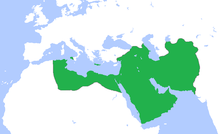
The Islamic era began in 622. Islamic armies conquered Arabia, Egypt and Mesopotamia, eventually displacing the Persian and Byzantine Empires from the region. Within a century, Islam had reached the area of present-day Portugal in the west and Central Asia in the east. The Islamic Golden Age (roughly between 692 and 945) spanned the periods of the Umayyad Caliphate (661-750) and, in particular, the early phase of the succeeding Abbasid Caliphate (750–1258), with stable political structures and flourishing trade. Major religious and cultural works of the Islamic empire were translated into Arabic. Islamic culture inherited Greek, Indic, Assyrian and Persian influences. A new common civilisation formed, based on Islam. An era of high culture and innovation ensued, with rapid growth in population and cities. The Arab Agricultural Revolution in the countryside brought more crops and improved agricultural technology, especially irrigation. This supported the larger population and enabled culture to flourish.[1][2] From the 8th century onwards, scholars such as Al-Kindi[3] translated Indian, Assyrian, Sasanian (Persian) and Greek knowledge, including the works of Aristotle, into Arabic. These translations supported advances by scientists across the Islamic world.[4]
Islamic science survived the initial Christian reconquest of Spain, including the fall of Seville in 1248, as work continued in the eastern centres (such as in Persia). After the completion of the Spanish reconquest in 1492, the Islamic world went into an economic and cultural decline.[2] The Abbasid caliphate was followed by the Ottoman Empire (c. 1299–1922), centred in Turkey, and the Safavid Empire (1501–1736), centred in Persia, where work in the arts and sciences continued.[5]
Fields of inquiry
Islamic scientific achievements encompass a wide range of subject areas, especially mathematics, astronomy, and medicine.[4] Other subjects of scientific inquiry included physics, alchemy and chemistry, ophthalmology, and geography and cartography.[6]
Alchemy and chemistry
Alchemy was already well established before the rise of Islam. It was based on the belief that substances were made up of the four Aristotelian elements, fire, earth, air, and water in different proportions. Alchemists supposed that gold was the noblest metal, and that other metals formed a series down to the basest, such as lead. They believed, too, that a fifth element, the elixir, could transform a base metal into gold. Jabir ibn Hayyan (8th–9th centuries) wrote on alchemy, based on his own experiments. He described laboratory techniques and experimental methods that would continue to be used when alchemy had transformed into chemistry. Ibn Hayyan identified many substances including sulphuric and nitric acids. He described processes such as sublimation, reduction and distillation. He made use of equipment such as the alembic and the retort stand.[7][8][9]
Astronomy and cosmology

Astronomy was a major discipline within Islamic science. Effort was devoted both towards understanding the nature of the cosmos and to practical purposes. One of these was determining the Qibla, the direction in which to pray. Another was astrology, predicting events affecting human life and selecting suitable times for actions such as going to war or founding a city.[10] Al-Battani (850–922) accurately determined the length of the solar year. He contributed to the Tables of Toledo, used by astronomers to predict the movements of the sun, moon and planets across the sky. Some of his astronomic tables were later used by Copernicus.[11]
Al-Zarqali (1028–1087) developed a more accurate astrolabe, used for centuries afterwards. He constructed a water clock in Toledo. He discovered that the Sun's apogee moves slowly relative to the fixed stars, and obtained a good estimate of its motion[12] for its rate of change.[13] Nasir al-Din al-Tusi (1201–1274) wrote an important revision to Ptolemy's celestial model. When he became Helagu's astrologer, he was given an observatory and gained access to Chinese techniques and observations. He developed trigonometry as a separate field, and compiled the most accurate astronomical tables available up to that time.[14]

Botany
The study of the natural world extended to a detailed examination of plants. The work done was directly useful in the unprecedented growth of pharmacology across the Islamic world. Al-Dinawari popularised botany in the Islamic world with his six-volume Kitab al-Nabat (Book of Plants). Only volumes 3 and 5 have survived, with part of volume 6 reconstructed from quoted passages. In what survives, 637 plants are described in alphabetical order from the letters sin to ya, so the whole book must have covered several thousand kinds of plants. Al-Dinawari described the phases of plant growth and the production of flowers and fruit. Zakariya al-Qazwini's thirteenth century encyclopedia ʿAjā'ib al-makhlūqāt (The Wonders of Creation) contained, among many other topics, both realistic botany and fantastic accounts. For example, he described trees which grew birds on their twigs in place of leaves, but which could only be found in the far-distant British Isles.[15][16][17] The use and cultivation of plants was documented in the 11th century by Muhammad bin Ibrāhīm Ibn Bassāl of Toledo in his book Dīwān al-filāha (The Court of Agriculture), and Ibn al-'Awwam al-Ishbīlī of Seville in his 12th century book Kitāb al-Filāha (Treatise on Agriculture).[18] Ibn Bassāl had travelled widely across the Islamic world, returning with a detailed knowledge of agronomy. His practical and systematic book describes over 180 plants and how to propagate and care for them. It covered leaf and root vegetables, herbs, spices and trees.[19] Abū l-Khayr described in minute detail how olive trees should be grown, grafted, treated for disease, and harvested. He gave similar detail for crops such as cotton.[18]
Geography and cartography

The swift spread of Islam across Western Asia and North Africa encouraged an unprecedented growth in trade and travel by land and sea as far away as Southeast Asia, China, much of Africa, Scandinavia and even Iceland. Geographers worked to create increasingly accurate maps of the known world, starting from many existing but fragmentary sources.[20] Abu Zayd al-Balkhi (850–934), founder of the Balkhī school of cartography in Baghdad, wrote an atlas called Figures of the Regions (Suwar al-aqalim).[21] Al-Biruni (973–1048) measured the radius of the earth using a new method. It involved observing the height of a mountain at Nandana (now in Pakistan).[22] Al-Idrisi (1100–1166) created a map of the world for Roger, the Norman King of Sicily. He also wrote the Tabula Rogeriana (Book of Roger), a geographic study of the peoples, climates, resources and industries of the whole of the world known at that time.[23] The Ottoman admiral Piri Reis (c. 1470–1553) made a map of the New World and West Africa in 1513. He made use of maps from Greece, Portugal, Muslim sources, and perhaps one made by Christopher Columbus. He was part of a major tradition of Ottoman cartography.[24]
-
Modern copy of al-Idrisi's 1154 Tabula Rogeriana, upside-down, North at top
Mathematics
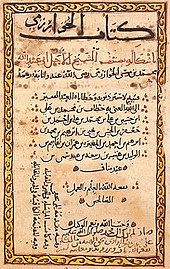
Islamic mathematicians gathered, organised and clarified the mathematics they inherited from ancient Egypt, Greece, India, Mesopotamia and Persia, and went on to make innovations of their own. Islamic mathematics can be divided into algebra, geometry and arithmetic. Algebra was mainly used for recreation: it had few practical applications at that time. Geometry was studied at different levels. Some texts contain practical geometrical rules for surveying and for measuring figures. Theoretical geometry was a necessary prerequisite for understanding astronomy and optics, and it required years of concentrated work. Early in the Abbasid caliphate, soon after Baghdad was founded in the mid-eighth century, some mathematical knowledge was assimilated from the pre-Islamic Persian tradition in astronomy. Astronomers from India were invited to the court of the caliph in the late eighth century; they explained the rudimentary trigonometrical techniques used in Indian astronomy. Ancient Greek works such as Ptolemy's Almagest and Euclid's Elements were translated into Arabic. By the second half of the ninth century, Islamic mathematicians were already making contributions to the most sophisticated parts of Greek geometry. Islamic mathematics reached its apogee in the Eastern part of the Islamic world between the tenth and twelfth centuries. Most mathematical works were written in Arabic, others in Persian.[25][26][27]
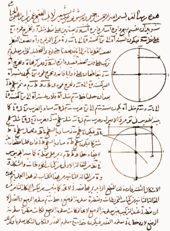
al-Khwarizmi (8th–9th centuries), considered the greatest mathematician of Islamic civilization, was instrumental in the adoption of the Indian numbering system. He developed algebra, which also had Indian antecedents, introduced methods of simplifying equations, and used Euclidean geometry in his proofs.[28][29] Ibn Ishaq al-Kindi (801–873) worked on cryptography for the caliphate.[30] Avicenna (ca. 980–1037) contributed to mathematical techniques such as casting out nines.[31] Thābit ibn Qurra (835–901) calculated the solution to a chessboard problem involving an exponential series.[32] al-Farabi (ca. 870–950) attempted to describe, geometrically, the repeating patterns popular in Islamic decorative motifs in his book Spiritual Crafts and Natural Secrets in the Details of Geometrical Figures.[33] Omar Khayyam (1048–1131), known in the West as a poet, calculated the length of the year to within 5 decimal places. He found geometric solutions to all 13 forms of cubic equations. He developed some quadratic equations still in use.[34] Jamshīd al-Kāshī (ca. 1380–1429) is credited with several theorems of trigonometry including the law of cosines, also known as Al-Kashi's Theorem. He is often credited with the invention of decimal fractions, and a method like Horner's to calculate roots. He calculated π correct to 17 significant figures.[35]
Medicine

Islamic society paid careful attention to medicine, following a hadith enjoining the preservation of good health. Its physicians inherited knowledge and traditional medical beliefs from the civilisations of classical Greece, Rome, Syria, Persia and India. These included the writings of Hippocrates such as the theory of the four humours, and the theories of Galen.[36] al-Razi (ca. 854–925/935) identified smallpox and measles, and recognized that fever was a part of the body's defenses. He wrote a 23-volume compendium of Chinese, Indian, Persian, Syriac and Greek medicine. al-Razi questioned the classical Greek medical theory of how the four humours regulate life processes. He challenged Galen's work on several fronts, including the treatment of bloodletting, arguing that it was effective.[37] al-Zahrawi (936–1013) was a surgeon whose most important surviving work is referred to as al-Tasrif (Medical Knowledge). It is a 30 volume set mainly discussing medical symptoms, treatments, and pharmacology. The last volume, on surgery, describes surgical instruments, supplies, and pioneering procedures.[38] Avicenna (ca. 980–1037) wrote the major medical textbook, The Canon of Medicine.[31] ibn al-Nafis (1213–1288) wrote an influential book on medicine; it is believed to have replaced Avicenna's Canon in the Islamic world. He wrote commentaries on Galen and Avicenna's works. One of these commentaries, discovered in 1924, described the circulation of blood through the lungs.[39][40]
Optics and ophthalmology
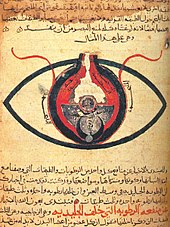

Optics developed rapidly in this period. By the ninth century, there were works on physiological, geometrical and physical optics. Topics covered included mirror reflection. Hunayn ibn Ishaq (809–873) wrote the book Ten Treatises on the Eye; this was influential in the West until the 17th century.[43] Abbas ibn Firnas (810–887) developed lenses for magnification and the improvement of vision.[44] Ibn Sahl (ca. 940–1000) discovered the law of refraction known as Snell's law. He used the law to produce the first Aspheric lenses that focused light without geometric aberrations.[45][46]
In the eleventh century, Ibn al-Haytham (Alhazen, 965–1040) rejected the Greek ideas about vision, whether the Aristotelian tradition that held that the form of the perceived object entered the eye (but not its matter), or that of Euclid and Ptolemy that held that the eye emitted a ray. Al-Haytham proposed in his Book of Optics that vision occurs by way of light rays forming a cone with its vertex at the center of the eye. He suggested that light was reflected from different surfaces in different directions, thus causing objects to look different.[47][48][49][50] He argued further that the mathematics of reflection and refraction needed to be consistent with the anatomy of the eye.[51]
Pharmacology

Advances in botany and chemistry in the Islamic world encouraged developments in pharmacology. Muhammad ibn Zakarīya Rāzi (Rhazes) (865–915) promoted the medical uses of chemical compounds. Abu al-Qasim al-Zahrawi (Abulcasis) (936–1013) pioneered the preparation of medicines by sublimation and distillation. His Liber servitoris provides instructions for preparing "simples" from which were compounded the complex drugs then used. Sabur Ibn Sahl (d 869), was the first physician to describe a large variety of drugs and remedies for ailments. Al-Biruni (973–1050) wrote the Kitab al-Saydalah (The Book of Drugs), describing in detail the properties of drugs, the role of pharmacy and the duties of the pharmacist. Ibn Sina (Avicenna) described 700 preparations, their properties, mode of action and their indications. He devoted a whole volume to simples in The Canon of Medicine. Works by Masawaih al-Mardini (c. 925–1015) and Ibn al-Wafid (1008–1074) were printed in Latin more than fifty times, appearing as De Medicinis universalibus et particularibus by Mesue the younger, and the Medicamentis simplicibus by Abenguefit respectively. Peter of Abano (1250–1316) translated and added a supplement to the work of al-Mardini under the title De Veneris. Al-Muwaffaq, in the 10th century, wrote The foundations of the true properties of Remedies, describing chemicals such as arsenious oxide and silicic acid. He distinguished between sodium carbonate and potassium carbonate, and drew attention to the poisonous nature of copper compounds, especially copper vitriol, and also lead compounds.[52][16]
Physics

The fields of physics studied in this period, apart from optics and astronomy which are described separately, are aspects of mechanics: statics, dynamics, kinematics and motion. In the sixth century John Philoponus rejected the Aristotelian view of motion. He argued instead that an object acquires an inclination to move when it has a motive power impressed on it. In the eleventh century, Ibn Sina adopted roughly the same idea, namely that a moving object has force which is dissipated by external agents like air resistance.[53] Ibn Sina distinguished between 'force' and 'inclination' (mayl); he claimed that an object gained mayl when the object is in opposition to its natural motion. He concluded that continuation of motion depends on the inclination that is transferred to the object, and that the object remains in motion until the mayl is spent. He also claimed that a projectile in a vacuum would not stop unless it is acted upon. That view is consistent with Newton's first law of motion, on inertia.[54] As a non-Aristotelian suggestion, it was essentially abandoned until it was described as "impetus" by Jean Buridan (c. 1295–1363), who was influenced by Ibn Sina's Book of Healing.[53]
In Abū Rayḥān al-Bīrūnī's (973–1048) Shadows, non-uniform motion is described as the result of acceleration.[55] Ibn-Sina's theory of mayl tried to relate the velocity and weight of a moving object, a precursor of the concept of momentum.[56] Aristotle's theory of motion stated that a constant force produces a uniform motion; Abu'l-Barakāt al-Baghdādī (c. 1080 – 1164/5) disagreed, arguing that velocity and acceleration are two different things, and that force is proportional to acceleration, not to velocity.[57]
Ibn Bajjah (Avempace, c. 1085–1138) proposed that for every force there is a reaction force. While he did not specify that these forces be equal, it was still an early version of Newton's third law of motion.[58]
The Banu Musa brothers, Jafar-Muhammad, Ahmad and al-Hasan (ca. early 9th century) created automated devices described in their Book of Ingenious Devices.[59][60][61]
Zoology

Many classical works including those of Aristotle were transmitted from Greek to Syriac, then to Arabic, then to Latin in the Middle Ages. Aristotle's zoology remained dominant in its field for the next two thousand years.[62] The Kitāb al-Hayawān (كتاب الحيوان, English: Book of Animals) is a 9th-century Arabic translation of History of Animals: 1–10, On the Parts of Animals: 11–14,[63] and Generation of Animals: 15–19.[64][65]
The book was mentioned by Al-Kindī (d. 850), and commented on by Avicenna (Ibn Sīnā) in his The Book of Healing. Avempace (Ibn Bājja) and Averroes (Ibn Rushd) commented on and criticised On the Parts of Animals and Generation of Animals.[66]
Significance
Historians of science differ in their views of the significance of the scientific accomplishments in the medieval Islamic world. The traditionalist view, exemplified by Bertrand Russell,[67] holds that Islamic science, while admirable in many technical ways, lacked the intellectual energy required for innovation and was chiefly important for preserving ancient knowledge, and handing it on to medieval Europe. The revisionist view, exemplified by Abdus Salam,[68] George Saliba[69] and John M. Hobson[70] holds that a Muslim scientific revolution occurred during the Middle Ages.[71] Scholars such as Donald Routledge Hill and Ahmad Y. Hassan argue that Islam was the driving force behind these scientific achievements.[72]
According to Ahmed Dallal, science in medieval Islam was "practiced on a scale unprecedented in earlier human history or even contemporary human history".[73] Toby Huff takes the view that, although science in the Islamic world did produce innovations, it did not lead to a scientific revolution, which in his view required an ethos that existed in Europe in the twelfth and thirteenth centuries, but not elsewhere in the world.[74][75][76] Will Durant, Fielding H. Garrison, Hossein Nasr and Bernard Lewis held that Muslim scientists helped in laying the foundations for an experimental science with their contributions to the scientific method and their empirical, experimental and quantitative approach to scientific inquiry.[77][78][79][80]
James E. McClellan III and Harold Dorn, reviewing the place of Islamic science in world history, comment that the positive achievement of Islamic science was simply to flourish, for centuries, in a wide range of institutions from observatories to libraries, madrasas to hospitals and courts, both at the height of the Islamic golden age and for some centuries afterwards. It plainly did not lead to a scientific revolution like that in Early modern Europe, but in their view, any such external comparison is just an attempt to impose "chronologically and culturally alien standards" on a successful medieval culture.[2]
See also
References
- ^ Hodgson, Marshall (1974). The Venture of Islam; Conscience and History in a World Civilisation Vol 1. University of Chicago. pp. 233–238. ISBN 978-0-226-34683-0.
- ^ a b c McClellan and Dorn 2006, pp.103–115
- ^ "Al-Kindi". Stanford Encyclopedia of Philosophy. 17 March 2015.
- ^ a b Robinson, Francis, ed. (1996). The Cambridge Illustrated History of the Islamic World. Cambridge University Press. pp. 228–229.
{{cite book}}: Unknown parameter|editorlink=ignored (|editor-link=suggested) (help) - ^ Turner 1997, p.7
- ^ Turner 1997, Table of contents
- ^ Masood 2009, pp.153–155
- ^ Lagerkvist, Urf (2005). The Enigma of Ferment: from the Philosopher's Stone to the First Biochemical Nobel Prize. World Scientific Publishing. p. 32.
- ^ Turner 1997, pp.189–194
- ^ Turner 1997, pp.59–116
- ^ Masood 2009, pp.74, 148–150
- ^ Linton (2004), p.97). Owing to the unreliability of the data al-Zarqali relied on for this estimate, its remarkable accuracy was fortuitous.
- ^ Masood 2009, pp.73–75
- ^ Masood 2009, pp.132–135
- ^ Fahd, Toufic, Botany and agriculture, p. 815, in Morelon & Rashed 1996, pp.813–852
- ^ a b Turner 1997, pp.138–139
- ^ Turner 1997, pp.162–188
- ^ a b Zaimeche, Salah (August 2002). "Agriculture in Muslim civilisation : A Green Revolution in Pre-Modern Times". Muslim Heritage.
- ^ "Ibn Baṣṣāl: Dīwān al-filāḥa / Kitāb al-qaṣd wa'l-bayān". The Filaha Texts Project: The Arabic Books of Husbandry. Retrieved 11 April 2017.
- ^ Turner 1997, pp.117–130
- ^ Edson, E.; Savage-Smith, Emilie (2004). Medieval Views of the Cosmos. Bodleian Library. pp. 61–3. ISBN 978-1-851-24184-2.
{{cite book}}: CS1 maint: multiple names: authors list (link) - ^ Pingree, David. "BĪRŪNĪ, ABŪ RAYḤĀN iv. Geography". Encyclopædia Iranica. Columbia University. ISBN 1-56859-050-4.
- ^ Masood 2009, pp.79–80
- ^ Turner 1997, pp.128–129
- ^ Meri, Josef W. (January 2006). Medieval Islamic Civilization, Volume 1: An Encyclopedia. Routledge. pp. 484–485. ISBN 978-0-415-96691-7.
- ^ Turner 1997, pp.43–58
- ^ Hogendijk, Jan P.; Berggren, J. L. (1989). "Episodes in the Mathematics of Medieval Islam by J. Lennart Berggren". Journal of the American Oriental Society. 109 (4): 697–698. doi:10.2307/604119. JSTOR 604119.
- ^ Toomer, Gerald (1990). "Al-Khwārizmī, Abu Jaʿfar Muḥammad ibn Mūsā". In Gillispie, Charles Coulston. Dictionary of Scientific Biography. 7. New York: Charles Scribner's Sons. ISBN 0-684-16962-2.
- ^ Masood 2009, pp.139–145
- ^ Masood 2009, pp.49–52
- ^ a b Masood 2009, pp.104–105
- ^ Masood 2009, pp.48–49
- ^ Masood 2009, pp.148–149
- ^ Masood 2009, pp.5, 104, 145–146
- ^ O'Connor, John J.; Robertson, Edmund F., "Ghiyath al-Din Jamshid Mas'ud al-Kashi", MacTutor History of Mathematics archive, University of St Andrews.
- ^ Turner 1997, pp.131–161
- ^ Masood 2009, pp.74, 99–105
- ^ Masood 2009, pp.108–109
- ^ Masood 2009, pp.110–111
- ^ Turner 1997, pp.131–139
- ^ Jim Al-Khalili (4 January 2009). "The 'first true scientist'". BBC News.
- ^ Tracey Tokuhama-Espinosa (2010). Mind, Brain, and Education Science: A Comprehensive Guide to the New Brain-Based Teaching. W. W. Norton & Company. p. 39. ISBN 9780393706079.
Alhazen (or Al-Haytham; 965–1039 CE) was perhaps one of the greatest physicists of all times and a product of the Islamic Golden Age or Islamic Renaissance (7th–13th centuries). He made significant contributions to anatomy, astronomy, engineering, mathematics, medicine, ophthalmology, philosophy, physics, psychology, and visual perception and is primarily attributed as the inventor of the scientific method, for which author Bradley Steffens (2006) describes him as the "first scientist".
- ^ Masood 2009, pp.47–48, 59, 96–97, 171–72
- ^ Masood 2009, pp.71–73
- ^ K. B. Wolf, "Geometry and dynamics in refracting systems", European Journal of Physics 16, p. 14–20, 1995.
- ^ R. Rashed, "A pioneer in anaclastics: Ibn Sahl on burning mirrors and lenses", Isis 81, p. 464–491, 1990
- ^ Dallal, Ahmad (2010). Islam, Science, and the Challenge of History. Yale University Press. pp. 38–39.
- ^ Lindberg, David C. (1976). Theories of Vision from al-Kindi to Kepler. University of Chicago Press, Chicago. ISBN 0-226-48234-0. OCLC 1676198.
- ^ El-Bizri, Nader (2005). A Philosophical Perspective on Alhazen's Optics. Cambridge University Press. pp. 189–218.
{{cite book}}:|work=ignored (help) - ^ El-Bizri, Nader (30 March 2011). "Ibn al-Haytham". Muslim Heritage. Retrieved 9 July 2017.
- ^ Masood 2009, pp.173–175
- ^ Levey, M. (1973). Early Arabic Pharmacology. E. J. Brill.
- ^ a b Sayili, Aydin. "Ibn Sina and Buridan on the Motion the Projectile". Annals of the New York Academy of Sciences. 500 (1): 477–482. doi:10.1111/j.1749-6632.1987.tb37219.x.
- ^ Espinoza, Fernando (2005). "An Analysis of the Historical Development of Ideas About Motion and its Implications for Teaching". Physics Education. 40 (2): 139–146. doi:10.1088/0031-9120/40/2/002.
- ^ "Biography of Al-Biruni". University of St. Andrews, Scotland.
- ^ Nasr, S.H.; Razavi, M.A. (1996). The Islamic Intellectual Tradition in Persia. Routledge.
{{cite book}}: CS1 maint: multiple names: authors list (link) - ^ Pines, Shlomo (1986). Studies in Arabic versions of Greek texts and in mediaeval science. Vol. 2. Brill Publishers. p. 203. ISBN 965-223-626-8.
- ^ Franco, Abel B. "Avempace, Projectile Motion, and Impetus Theory". Journal of the History of Ideas. 64 (4): 543.
- ^ Masood 2009, pp.161–163
- ^ Lindberg, David (1978). Science in the Middle Ages. University of Chicago Press. pp. 23, 56.
- ^ Selin, Helaine, ed. (1997). Encyclopaedia of the History of Science, Technology, and Medicine in Non-Western Cultures. Kluwer Academic Publishers. pp. 151, 235, 375.
- ^ Hoffman, Eva R. (2013). Translating Image and Text in the Medieval Mediterranean World between the Tenth and Thirteenth Centuries. Brill. pp. 288–. ISBN 90-04-25034-4.
{{cite book}}:|work=ignored (help) - ^ Kruk, R., 1979, The Arabic Version of Aristotle's Parts of Animals: book XI–XIV of the Kitab al-Hayawan, Royal Netherlands Academy of Arts and Sciences, Amsterdam-Oxford 1979.
- ^ Contadini, Anna (2012). A World of Beasts: A Thirteenth-Century Illustrated Arabic Book on Animals (the Kitab Na't al-Hayawan) in the Ibn Bakhtishu' Tradition). Leiden: Brill.
- ^ Kruk, R., 2003, "La zoologie aristotélicienne. Tradition arabe", DPhA Supplement, 329–334
- ^ Leroi, Armand Marie (2014). The Lagoon: How Aristotle Invented Science. Bloomsbury. pp. 354–355. ISBN 978-1-4088-3622-4.
{{cite book}}: Unknown parameter|titlelink=ignored (|title-link=suggested) (help) - ^ Bertrand Russell (1945), History of Western Philosophy, book 2, part 2, chapter X
- ^ Abdus Salam, H. R. Dalafi, Mohamed Hassan (1994). Renaissance of Sciences in Islamic Countries, p. 162. World Scientific, ISBN 9971-5-0713-7.
- ^ Saliba 1994, pp.245, 250, 256–257
- ^ Hobson 2004, p.178
- ^ Abid Ullah Jan (2006), After Fascism: Muslims and the struggle for self-determination, "Islam, the West, and the Question of Dominance", Pragmatic Publishings, ISBN 978-0-9733687-5-8.
- ^ Ahmad Y. Hassan and Donald Routledge Hill (1986), Islamic Technology: An Illustrated History, p. 282, Cambridge University Press
- ^ Dallal, Ahmad (2010). Islam, science, and the challenge of history. Yale University Press. p. 12. ISBN 978-0-300-15911-0.
- ^ Huff, Toby E. (2003) [1993]. The Rise of Early Modern Science: Islam, China and the West (2nd ed.). Cambridge University Press. pp. 209–239 and passim. ISBN 0-521-52994-8.
- ^ Huff, Toby E. (2003). The Rise of Early Modern Science: Islam, China, and the West. Cambridge University Press. ISBN 0-521-52994-8.
- ^ Saliba, George (Autumn 1999). "Seeking the Origins of Modern Science? Review of Toby E. Huff, The Rise of Early Modern Science: Islam, China and the West". Bulletin of the Royal Institute for Inter-Faith Studies. 1 (2).
- ^ Will Durant (1980). The Age of Faith (The Story of Civilization, Volume 4), p. 162–186. Simon & Schuster. ISBN 0-671-01200-2.
- ^ Nasr, Hossein (1976). Islamic Science: An Illustrated Study. ISBN 978-0-905035-02-4.
- ^ Fielding H. Garrison, An Introduction to the History of Medicine: with Medical Chronology, Suggestions for Study and Biblographic Data, p. 86
- ^ Lewis, Bernard (2001). What Went Wrong? : Western Impact and Middle Eastern Response. Oxford University Press. p. 79. ISBN 0-19-514420-1.
Sources
- Hobson, John M. (2004). The Eastern Origins of Western Civilisation. Cambridge University Press. ISBN 0-521-54724-5.
{{cite book}}: Invalid|ref=harv(help) - Linton, Christopher M. (2004). From Eudoxus to Einstein—A History of Mathematical Astronomy. Cambridge University Press. ISBN 978-0-521-82750-8.
{{cite book}}: Invalid|ref=harv(help) - Masood, Ehsan (2009). Science and Islam: A History. Icon Books. ISBN 978-1-785-78202-2.
{{cite book}}: Invalid|ref=harv(help) - McClellan, James E. III; Dorn, Harold, eds. (2006). Science and Technology in World History (2 ed.). Johns Hopkins. ISBN 978-0-8018-8360-6.
{{cite book}}: Invalid|ref=harv(help) - Morelon, Régis; Rashed, Roshdi (1996). Encyclopedia of the History of Arabic Science. Vol. 3. Routledge. ISBN 0-415-12410-7.
{{cite book}}: Invalid|ref=harv(help) - Saliba, George (1994). A History of Arabic Astronomy: Planetary Theories During the Golden Age of Islam. New York University Press. ISBN 0-8147-8023-7.
{{cite book}}: Invalid|ref=harv(help) - Turner, Howard R. (1997). Science in Medieval Islam: An Illustrated Introduction. University of Texas Press. ISBN 0-292-78149-0.
{{cite book}}: Invalid|ref=harv(help)
Further reading
- Al-Daffa, Ali Abdullah; Stroyls, J.J. (1984). Studies in the exact sciences in medieval Islam. Wiley. ISBN 0-471-90320-5.
- Hogendijk, Jan P.; Sabra, Abdelhamid I. (2003). The Enterprise of Science in Islam: New Perspectives. MIT Press. ISBN 0-262-19482-1.
- Hill, Donald Routledge (1993). Islamic Science And Engineering. Edinburgh University Press. ISBN 0-7486-0455-3.
- Kennedy, Edward S. (1983). Studies in the Islamic Exact Sciences. Syracuse University Press. ISBN 0-8156-6067-7.
- Morelon, Régis; Rashed, Roshdi (1996). Encyclopedia of the History of Arabic Science. Vol. 2–3. Routledge. ISBN 0-415-02063-8.
- Saliba, George (2007). Islamic Science and the Making of the European Renaissance. MIT Press. ISBN 0-262-19557-7.
External links
- "How Greek Science Passed to the Arabs" by De Lacy O'Leary
- Saliba, George. "Whose Science is Arabic Science in Renaissance Europe?".
- Habibi, Golareh. is there such a thing as Islamic science? the influence of Islam on the world of science, Science Creative Quarterly.


